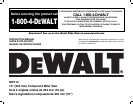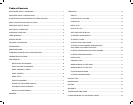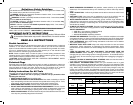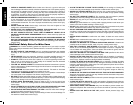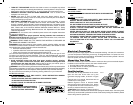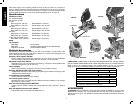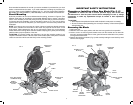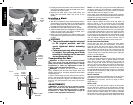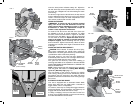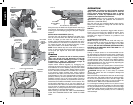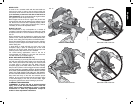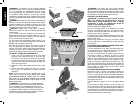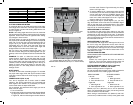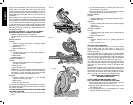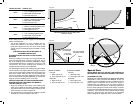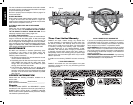
English
3
ON GUARD:
DANGER – KEEP AWAY FROM BLADE.
ON UPPER GUARD:
PROPERLY SECURE BRACKET WITH BOTH SCREWS BEFORE
USE.
ON TABLE: (2 PLACES)
WARNING: FOR YOUR OWN SAFETY READ INSTRUCTION
MANUAL BEFORE OPERATING MITER SAW.
KEEP HANDS OUT OF PATH OF SAW BLADE.
DO NOT OPERATE SAW WITHOUT GUARDS IN PLACE.
CHECK LOWER GUARD FOR PROPER CLOSING BEFORE EACH USE.
ALWAYS TIGHTEN ADJUSTMENT BEFORE USE. DO NOT PERFORM ANY
OPERATION FREEHAND.
NEVER REACH IN BACK OF SAW BLADE. NEVER CROSS ARMS IN FRONT
OF BLADE. TURN OFF TOOL AND WAIT FOR SAW BLADE TO STOP BEFORE
MOVING WORKPIECE, CHANGING SETTINGS OR MOVING HANDS.
DISCONNECT POWER BEFORE CHANGING BLADE OR SERVICING.
TO REDUCE THE RISK OF INJURY, ALLOW SAW TO RETURN TO THE
FULL UP POSITION AFTER EACH OPERATION. THINK! YOU CAN PREVENT
ACCIDENTS.
ON BASE: (2 PLACES)
Electrical Connection
Be sure your power supply agrees with the nameplate marking. 120 volts, AC means that
your saw will operate on alternating current only. A voltage decrease of 10 percent or more
will cause a loss of power and overheating. All D
EWALT tools are factory tested. If this tool
does not operate, check the power supply.
Unpacking Your Saw
Check the contents of your miter saw carton to make sure that you have received all parts.
In addition to this instruction manual, the carton should contain:
1. One No. DW713 miter saw with blade.
2. One blade wrench in wrench pocket shown in Figure 2.
3. One No. DW7053 Dust Bag.
Familiarization
Your miter saw is fully assembled in the carton.
FIG. 1
Open the box and lift the saw out by the
convenient carrying handle, as shown in Figure
1.
Place the saw on a smooth, flat surface such as
a workbench or strong table.
Examine Figures 2 and 3 to become familiar
with the saw and its various parts. The section
on adjustments will refer to these terms and you
must know what and where the parts are.
CAUTION: Pinch Hazard. To reduce the risk of
injury, keep thumb underneath the handle when pulling the handle down. The lower guard
will move up as the handle is pulled down which could cause pinching.The handle is placed
close to the guard for special cuts.
• TURN OFF THE MACHINE and allow the blade to come to a complete stop before
raising the arm and prior to cleaning the blade area, removing debris in the path of the
blade, before servicing or adjusting tool. A moving blade can cause serious injury.
• PROPERLY SUPPORT LONG OR WIDE WORKPIECES. Loss of control of the
workpiece can cause injury.
• NEVER cross arms in front of blade while using tool. Always make a dry run
(unpowered) before making a finish cut so that you can check the path of the blade or
severe personal injury may result.
• ADDITIONAL INFORMATION regarding the safe and proper operation of power
tools (i.e. a safety video) is available from the Power Tool Institute, 1300 Sumner
Avenue, Cleveland, OH 44115-2851 (www.powertoolinstitute.com). Information is also
available from the National Safety Council, 1121 Spring Lake Drive, Itasca, IL 60143-
3201. Please refer to the American National Standards Institute ANSI 01.1 Safety
Requirements for Woodworking Machines and the U.S. Department of Labor OSHA
1910.213 Regulations.
WARNING: Do not connect unit to electrical power source until complete instructions
are read and understood.
WARNING: Always wear proper personal hearing protection that conforms to
ANSI S12.6 (S3.19) during use. Under some conditions and duration of use, noise from
this product may contribute to hearing loss.
WARNING: NEVER MAKE ANY CUT UNLESS THE MATERIAL IS SECURED ON
THE TABLE AND AGAINST THE FENCE.
WARNING: Some dust created by power sanding, sawing, grinding, drilling, and other
construction activities contains chemicals known to cause cancer, birth defects or other
reproductive harm. Some examples of these chemicals are:
• lead from lead-based paints,
• crystalline silica from bricks and cement and other masonry products, and
• arsenic and chromium from chemically-treated lumber (CCA).
Your risk from these exposures varies, depending on how often you do this type of work.
To reduce your exposure to these chemicals: work in a well ventilated area, and work
with approved safety equipment, such as those dust masks that are specially designed to
filter out microscopic particles.
• Avoid prolonged contact with dust from power sanding, sawing, grinding,
drilling, and other construction activities. Wear protective clothing and wash
exposed areas with soap and water. Allowing dust to get into your mouth, eyes, or
lay on the skin may promote absorption of harmful chemicals.
WARNING: Use of this tool can generate and/or disburse dust, which may cause serious
and permanent respiratory or other injury. Always use NIOSH/OSHA approved respiratory
protection appropriate for the dust exposure. Direct particles away from face and body.
For your convenience and safety, the following warning labels are on your miter saw.
ON MOTOR HOUSING:
WARNING: FOR YOUR OWN SAFETY, READ INSTRUCTION MANUAL
BEFORE OPERATING SAW.
WHEN SERVICING, USE ONLY IDENTICAL RE PLACE MENT PARTS.
ALWAYS WEAR EYE PROTECTION.
DO NOT EXPOSE TO RAIN OR USE IN DAMP LOCATIONS.
ON MOVING FENCE:
ALWAYS ADJUST FENCE PROPERLY
BEFORE USE. CLAMP SMALL PIECES
BEFORE CUTTING. SEE MANUAL.



